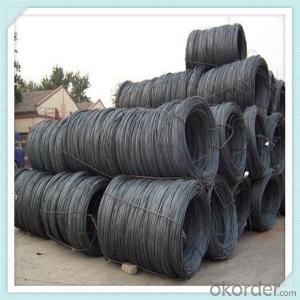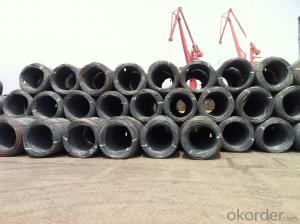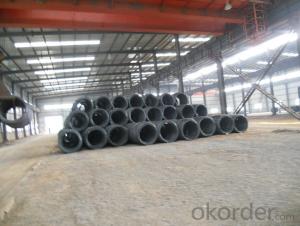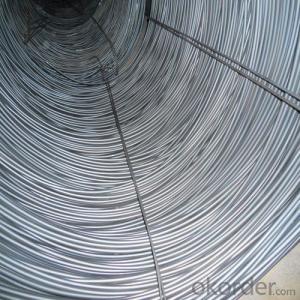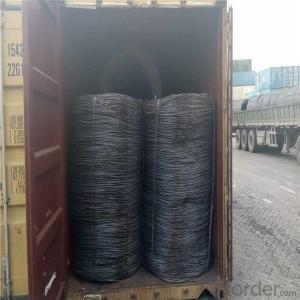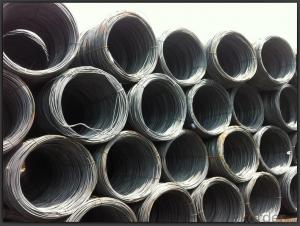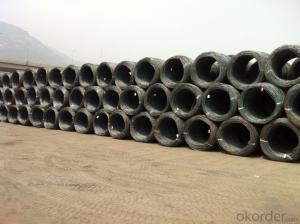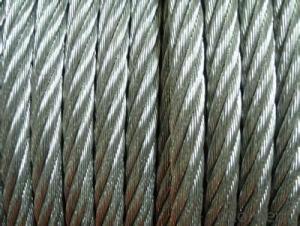SAE1008B Steel wire rod hot rolled low carbon
- Loading Port:
- Tianjin
- Payment Terms:
- TT OR LC
- Min Order Qty:
- 100 m.t.
- Supply Capability:
- 12532 m.t./month
OKorder Service Pledge
OKorder Financial Service
You Might Also Like
Specification
Features
1、Pure steel quality, stable chemical contents, small tolerance.
2、Constant Quality, good drawing performance.
3、High dimension accuracy degree, accuracy degree of Level C up to 80%, smooth surface, less scale,
easy to be pickled.
4、Automatic bundling with 4 lines by Machine in tidy and good looks
5、Big high quality percentage, small coil percentage, and heavy coil weight for Hard Coil.
6、High sorbitizing percentage.
Produced from billets at the rolling mill, wire rod is the basis of all steel wire, rope and fencing products.
The most important characteristic in determining wire rod’s end use is its drawability. Common low carbon
wire rod is used for nails, small shaped products, barbed wires, various wire nettings, steel chains, and
other applications. High Carbon wire rod uses include steel tire cords for automobiles, conveyor belts,
and pressure hoses. Other applications include bolts, nuts, and machine parts, as well as compression,
tension and torsion springs
Product Description :
Standard | AISI, ASTM, BS, DIN, GB, JIS |
Material/steel grade | Q195-Q235,SAE1006B,SAE1006CR, SAE1008B, SAE1008CR, SAE1010B, SAE1018B, or according to customers requirements |
Wire Gauge | 5.5-12mm |
Coil weight | 1.8-2.1mts |
MOQ | 25MT |
Delivery Time | 15-30 days after receipt of L/C or deposit by T/T |
Packing | In coil and load in container, if large quantity, by bulk vessel; Can be packed as customers' special requirements |
Payment terms | 1).100% irrevocable L/C at sight. 2).30% T/T prepaid and the balance against the copy of B/L. 3).30% T/T prepaid and the balance against L/C |
Application | widely used in machinery parts, manufacturing industry, electronics industry, metal tools and others |
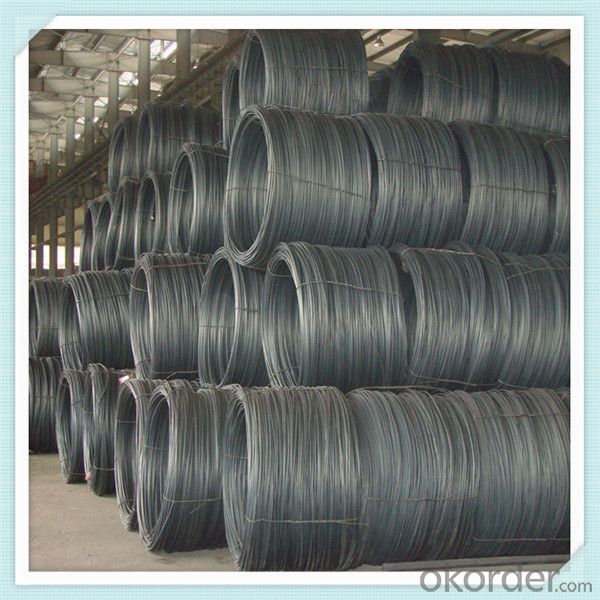
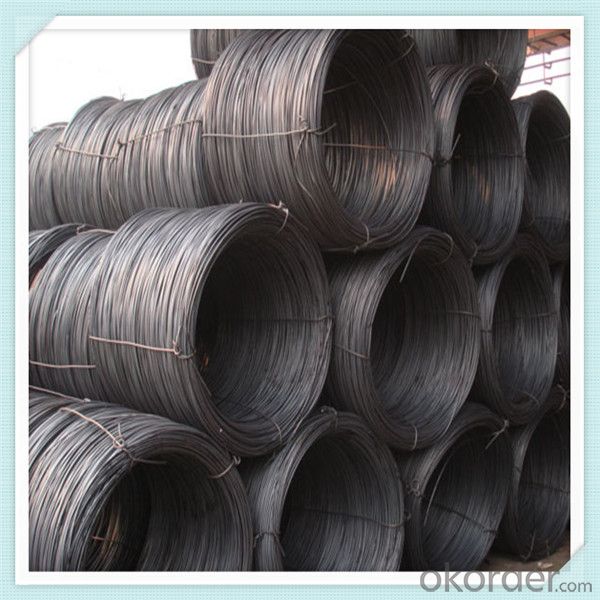
Application :
It generally used in braiding the hose for bathing product and machinery. With it
good flexibility, resistant to high temperature and resistant to corrosion, it
used widely in many industries.
Packing :
Hot-rolled wire rod is held in a unit with at least four steel straps in the
transverse direction and transported and stored without further packaging.
Before
the steel strapping is applied, the wire rod must be sufficiently compressed.
The strapping is fixed in the transverse direction with a single circumferential
strap so that the strapping does not slip and cause the coil to come apart.
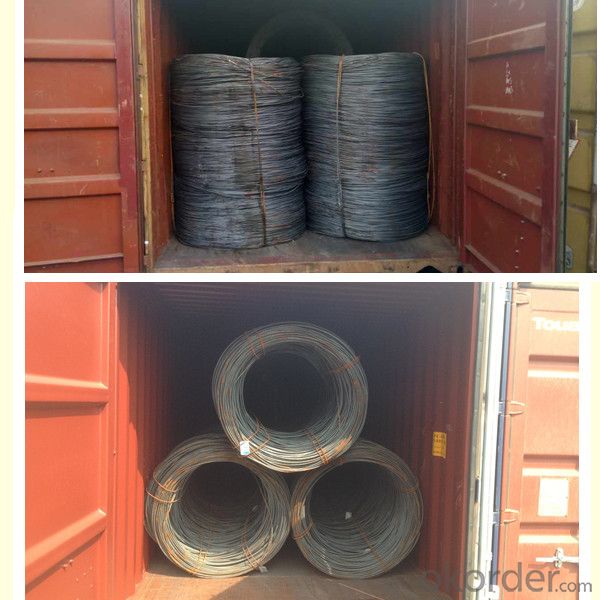
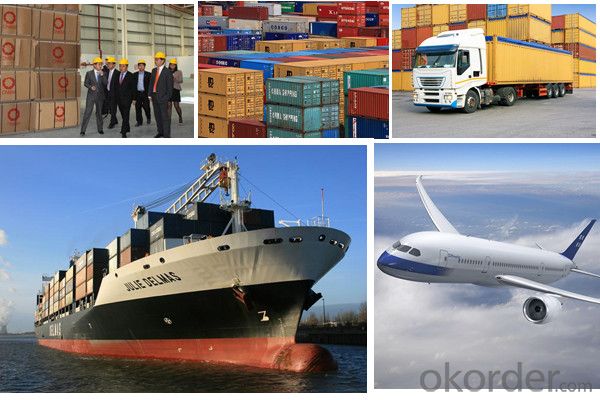
Our service:
(1) We cooperate with famous factories with advanced equipment and well trained workers.
(2) We can provide factory price with trading company service.
(3) We continuously work on the improvement of our processes, guaranteeing
consistently high standards of quality to keep none compensation.
(4) We guarantee 24 hours response and 48 hours solution providing service.
(5) We accept small order quantity before formal cooperation.
(6) We deliver the agreed quality at the agreed time, reacting to changes in
customer wishes in a flexible way.
(7) Due to our volume and selling power, we have excellent freight rates with
shipping lines.
(8) We strive to always be fair and honest in our dealings with customers.
(9) We strive to work together with customers to achieve much more than we can
achieve alone.
(10) Through our passion and commitment we aim to be a market leader in all our
key markets. To maintain our position as market leader we must continue to add
value in all that we do.
FAQ:
1.Q: What's your MOQ(minimum order quantity)?
A: One full container, mixed acceptable .
2. Q: What's your packing methods?
A: Packed in bundle or bulk ..
3. Q: How can I buy CNBM products in my country?
A:Please send us an inquiry or email ,we will reply to you if there is distributor in your country
4. Q: Can we visit your factory?
A: Warmly welcome. Once we have your schedule, we will arrange the
professional sales team to follow up your case.
5. Q: How long does it take to get the product if i place an order?
A:With the process of your requirements,we will pack and deliver in 3
-7 days. If it is by sea shipment,it will take 15-45 days depending on different locations
- Q: How is steel wire rod tested for ultimate tensile strength?
- Steel wire rod is typically tested for ultimate tensile strength using a universal testing machine. This machine applies a gradually increasing force to the rod until it fractures. The maximum force applied at the point of fracture is then used to determine the ultimate tensile strength of the steel wire rod.
- Q: How is the steel wire rod market affected by changes in trade policies?
- Changes in trade policies can have a significant impact on the steel wire rod market. Trade policies, such as tariffs or import/export restrictions, can affect the supply and demand dynamics of steel wire rods. If a country imposes tariffs on imported steel wire rods, it can lead to a decrease in imports and an increase in domestic production. This can result in higher prices for steel wire rods within the domestic market. Conversely, if trade policies are liberalized, allowing for easier import and export of steel wire rods, it can increase competition and potentially lower prices. Therefore, changes in trade policies can influence the competitiveness and profitability of companies in the steel wire rod market.
- Q: How is steel wire rod stored and handled to prevent damage?
- Steel wire rod is typically stored and handled with great care to prevent any damage that could compromise its quality and performance. To ensure the integrity of the wire rod, several measures are typically taken. Firstly, steel wire rod is stored in a designated area that is clean, dry, and well-ventilated. This minimizes the risk of exposure to moisture, which can lead to corrosion and rusting. Additionally, the storage area should be away from any potential sources of damage such as heavy machinery, sharp objects, or chemicals that could cause surface abrasions or chemical reactions. To prevent any physical damage, steel wire rod is often stacked on pallets or racks to keep them off the ground and protect them from any potential impact or contamination. The stacking height should be limited to avoid excessive pressure on the lower layers, which could result in deformation or breakage. Furthermore, steel wire rod is typically bundled or coiled to provide additional protection during storage and transportation. Bundling helps to maintain the shape and integrity of the wire rod, preventing any bending or warping. Coiling, on the other hand, is commonly used for longer lengths of wire rod and provides better handling and storage options. During handling, personnel should be trained in safe lifting and transportation techniques to prevent any mishaps that could damage the wire rod. The use of appropriate lifting equipment, such as cranes or forklifts, is recommended to minimize the risk of dropping or mishandling the wire rod. Regular inspections should also be conducted to identify and address any signs of damage or deterioration, such as surface rust, dents, or deformations. Any damaged wire rod should be promptly removed from storage and replaced to prevent further deterioration or potential safety hazards. By following these storage and handling practices, steel wire rod can be effectively protected from damage, ensuring its quality and performance are maintained throughout its lifespan.
- Q: What are the different surface marking materials used for steel wire rod?
- Steel wire rod can be marked using various surface marking materials to provide identification and traceability. Some commonly used materials include paint, ink, hot stamping, laser marking, and etching. 1. Paint is frequently used to mark steel wire rod and can display information like product identification, grade, and the manufacturer's logo. Paint markings are durable and can withstand handling and transportation. 2. Ink is another popular option for marking steel wire rod. It is applied through a printing process and can indicate product specifications, lot numbers, and barcodes. Ink markings are resistant to abrasion and offer high-contrast visibility. 3. Hot stamping involves applying a marking foil to the surface of the steel wire rod using heat and pressure. This technique transfers pre-printed information onto the rod, often including heat numbers, production dates, and customer-specific requirements. 4. Laser marking is a non-contact process that uses a laser beam to create permanent markings on the surface of the steel wire rod. This method allows for precise engraving of information like logos, serial numbers, and part numbers. Laser markings are highly durable and resistant to fading. 5. Etching is a chemical process that removes a thin layer of material from the surface of the steel wire rod. It creates indented markings that can be filled with paint or ink for increased visibility. Etched markings are resistant to abrasion and provide a long-lasting identification solution. The choice of surface marking material for steel wire rod depends on factors such as required durability, visibility, and specific application requirements. Each material offers its own advantages and can be customized to meet the needs of wire rod manufacturers and end-users.
- Q: How is steel wire rod used in the manufacturing of wire forms for automotive components?
- Steel wire rod is an essential component in the manufacturing of wire forms for automotive components. Wire forms are intricate shapes and designs made from metal wire, and they play a crucial role in various automotive applications such as springs, clips, brackets, and fasteners. The process begins with steel wire rods, which are typically made from carbon or alloy steel. These rods serve as the raw material for wire drawing, which is the primary method used to produce wire forms. Wire drawing involves pulling the steel wire rod through a series of dies to reduce its diameter and increase its length. This process helps to improve the wire's tensile strength and surface finish, making it suitable for automotive applications. Once the desired wire diameter is achieved through wire drawing, it is then fed into specialized machinery to create different wire forms. This machinery includes automated CNC (Computer Numerical Control) machines that can bend, shape, and cut the wire according to precise specifications. These machines use different tools and dies to form wire into the desired shape, ensuring accuracy and consistency. Wire forms manufactured from steel wire rod offer several advantages for automotive components. Firstly, steel wire rods provide excellent strength and durability, making them suitable for handling the demanding conditions within automotive systems. They can withstand high temperatures, vibrations, and mechanical stresses, ensuring the wire forms maintain their structural integrity over time. Moreover, steel wire rods offer flexibility in terms of design and customization. Manufacturers can easily create wire forms of various sizes, shapes, and configurations to meet the specific requirements of different automotive components. This versatility allows for the production of wire forms that are tailored to fit the precise needs of the automotive industry, enhancing the overall performance and functionality of the components. Additionally, steel wire rods are cost-effective and readily available, making them a preferred choice for wire form manufacturing in the automotive sector. The abundance of steel as a raw material ensures a stable supply chain, allowing manufacturers to meet the high demands of the automotive industry efficiently. In conclusion, steel wire rod is a crucial component in the manufacturing of wire forms for automotive components. Through the process of wire drawing and specialized machinery, steel wire rods are transformed into intricate shapes and designs that provide strength, durability, and flexibility. This enables the production of wire forms that meet the stringent requirements of automotive applications, ultimately contributing to the overall functionality and performance of automotive components.
- Q: How is steel wire rod used in the production of nails?
- Steel wire rod is used in the production of nails as it serves as the primary raw material for manufacturing nails. The wire rod is first drawn through a series of dies to reduce its diameter, resulting in a long, slender wire. This wire is then cut into the desired lengths and fed into a nail-making machine. The machine shapes and forms the wire into nails, which are then further processed and finished before being packaged for sale. Thus, steel wire rod plays a crucial role in the entire nail production process, serving as the foundation for creating durable and reliable nails.
- Q: What are the main competitors in the steel wire rod market?
- The main competitors in the steel wire rod market include companies like ArcelorMittal, Nippon Steel Corporation, Tata Steel, POSCO, and Evraz.
- Q: What are the common methods used to protect steel wire rod from corrosion?
- There are several common methods used to protect steel wire rods from corrosion. These include the application of protective coatings such as paint or galvanization, which creates a barrier between the steel and the corrosive elements. Another method is the use of corrosion inhibitors, which are chemicals that can be applied to the surface of the steel to prevent rust formation. Additionally, proper storage and handling practices, such as keeping the wire rods in a dry environment and avoiding exposure to moisture or corrosive substances, can also help protect against corrosion.
- Q: What are the different annealing processes used for steel wire rod?
- The different annealing processes used for steel wire rod include full annealing, spheroidization annealing, and process annealing. Full annealing involves heating the wire rod to a temperature above its critical temperature and then slowly cooling it to room temperature to soften it and improve its ductility. Spheroidization annealing is a type of full annealing that is specifically used for high carbon steel wire rod to transform its brittle cementite structure into spherical carbides, enhancing its machinability and reducing the risk of breakage. Process annealing, on the other hand, is a partial annealing process that is performed on cold-worked wire rod to relieve internal stresses and restore some of its ductility without affecting its mechanical properties.
- Q: How is steel wire rod used in the manufacturing of wire panels?
- Wire panels, which are widely utilized in construction, agriculture, and fencing industries, rely heavily on steel wire rod as a fundamental ingredient. To transform the steel wire rod into wire panels, a series of steps are initially carried out. To begin with, the steel wire rod undergoes the process of wire drawing using a machine. This procedure reduces the rod's diameter to the desired size. By pulling the wire rod through a sequence of dies, its thickness gradually decreases while its length increases. Subsequently, the drawn wire is cut into specific lengths that are determined by the required dimensions of the wire panels. Once the wire is cut, it is fed into a welding machine, where it is fused together to create a mesh-like structure. This welding process ensures that the wire panels possess both high tensile strength and structural integrity. Different welding techniques, such as resistance welding, spot welding, or fusion welding, are employed based on the specific demands of the wire panels. Following the welding process, the wire panels undergo a surface treatment, typically known as galvanizing. Galvanizing encompasses the application of a zinc coating on the wire panels to safeguard them against rust and corrosion. This additional layer of protection guarantees the longevity and durability of the wire panels, rendering them suitable for outdoor applications. Once the wire panels have been galvanized, further processing is carried out to attain the desired shape and size. This can involve cutting, bending, or molding the wire panels into specific configurations, depending on their intended usage. For instance, wire panels used in fencing may be bent to form zigzag or diamond patterns, while those employed in construction may be cut into rectangular shapes for reinforcement purposes. In conclusion, steel wire rod plays a vital role in the manufacturing of wire panels. Its exceptional attributes, including high tensile strength, flexibility, and resistance to corrosion, make it an ideal material for producing durable and versatile wire panels, which are widely utilized across diverse industries.
Send your message to us
SAE1008B Steel wire rod hot rolled low carbon
- Loading Port:
- Tianjin
- Payment Terms:
- TT OR LC
- Min Order Qty:
- 100 m.t.
- Supply Capability:
- 12532 m.t./month
OKorder Service Pledge
OKorder Financial Service
Similar products
Hot products
Hot Searches
Related keywords
